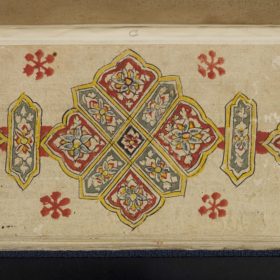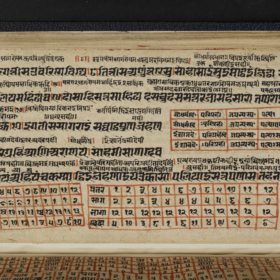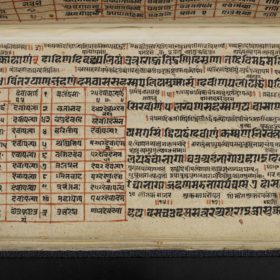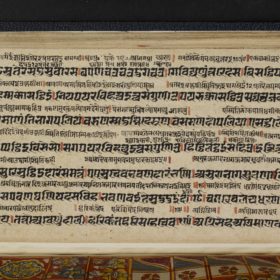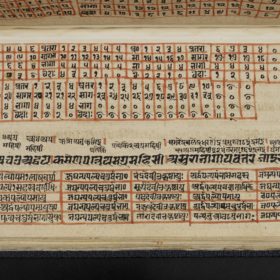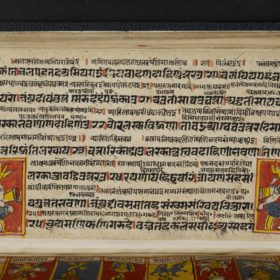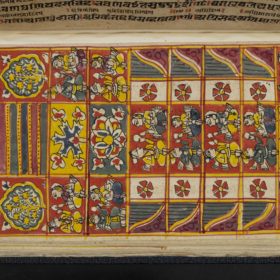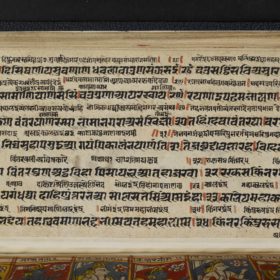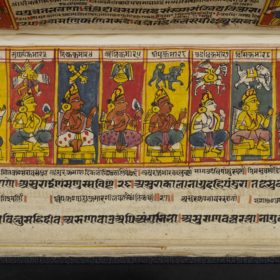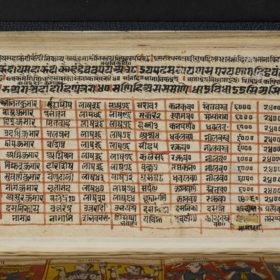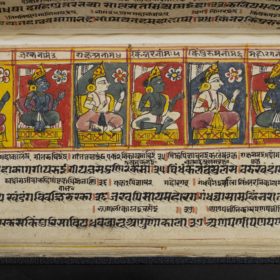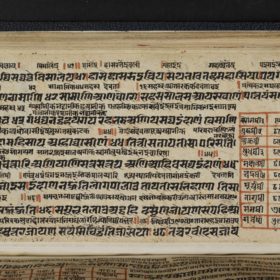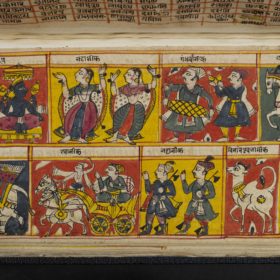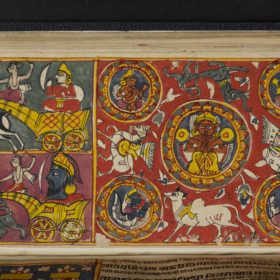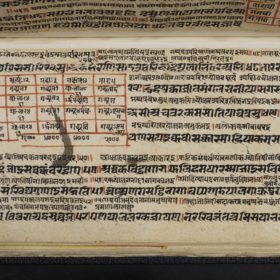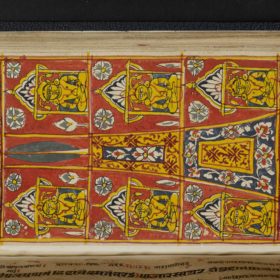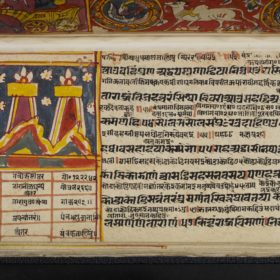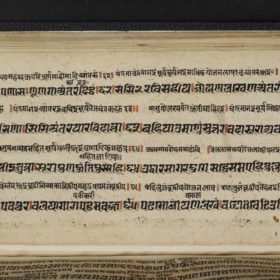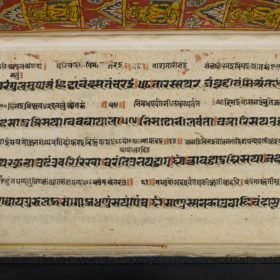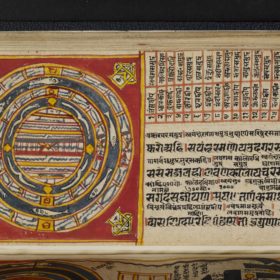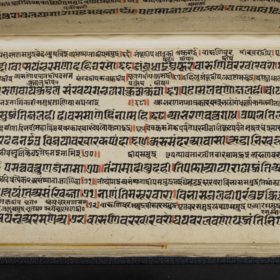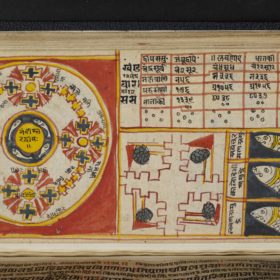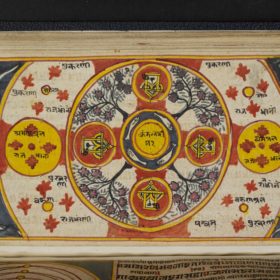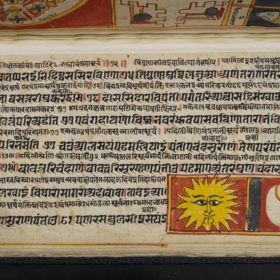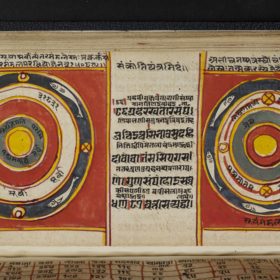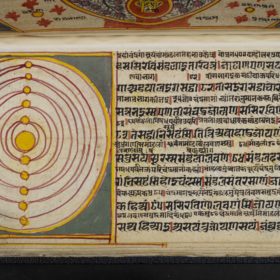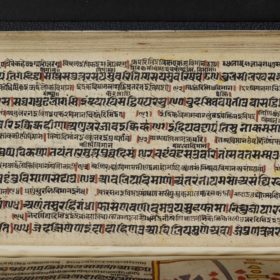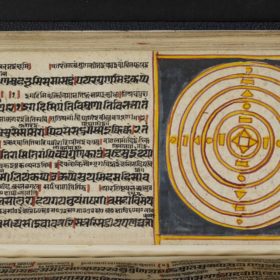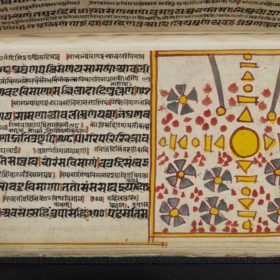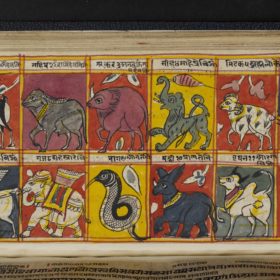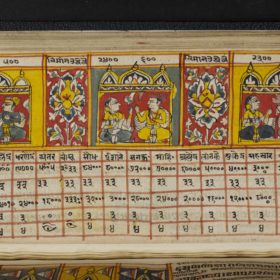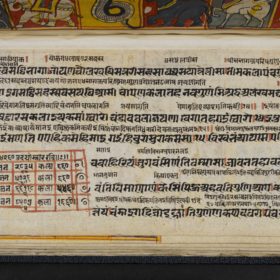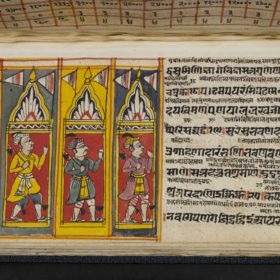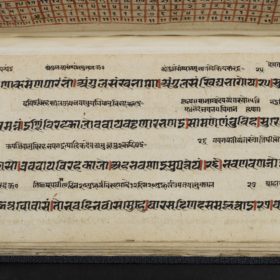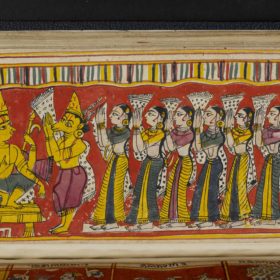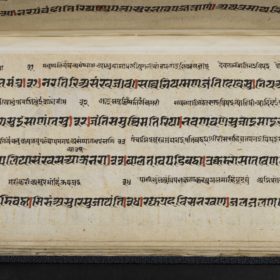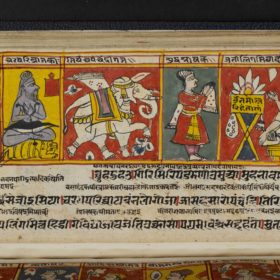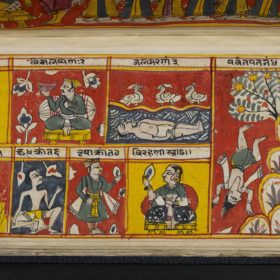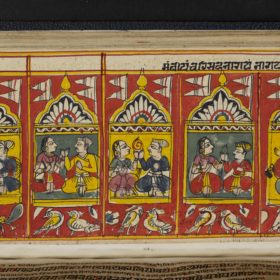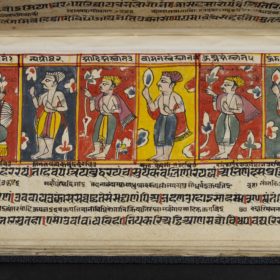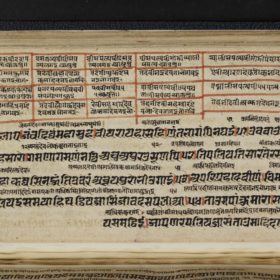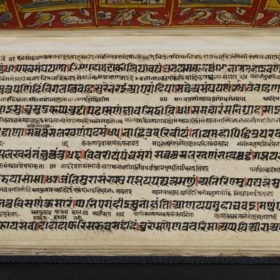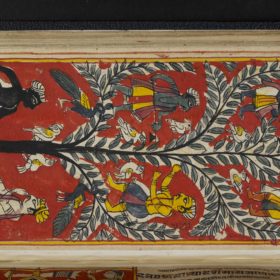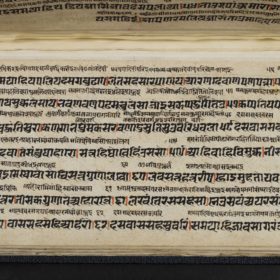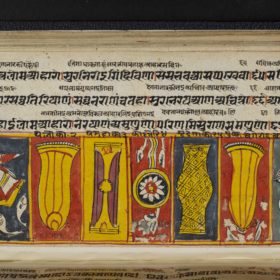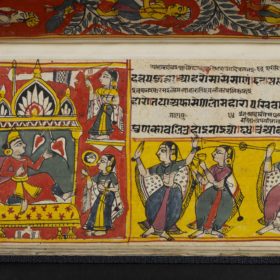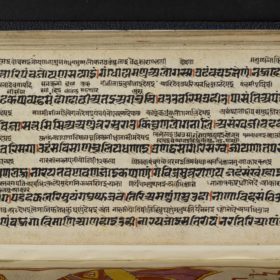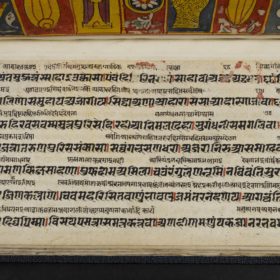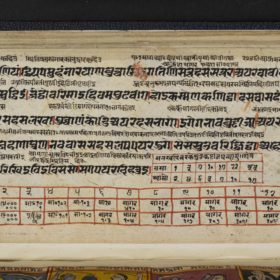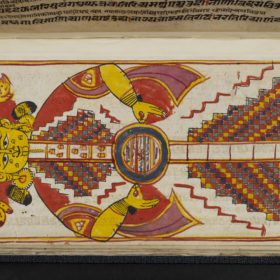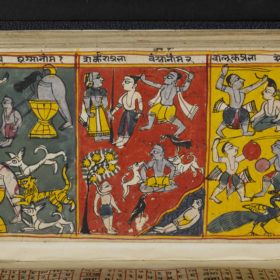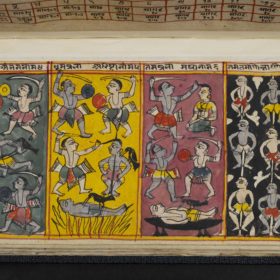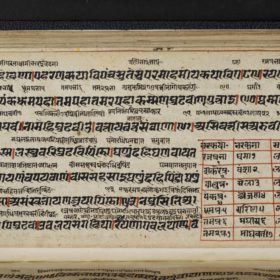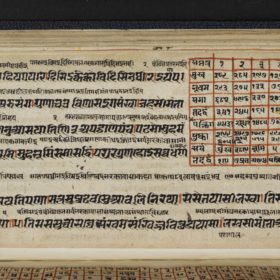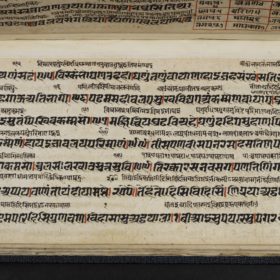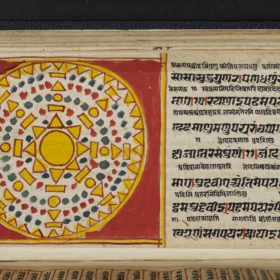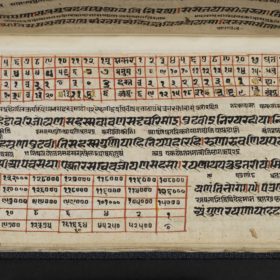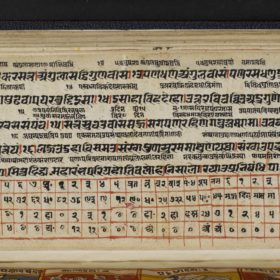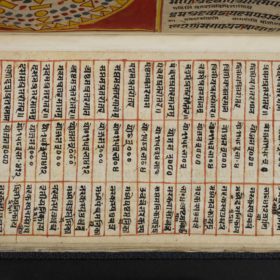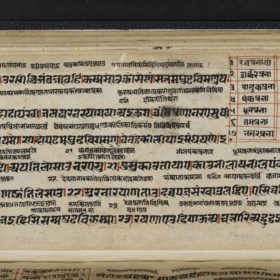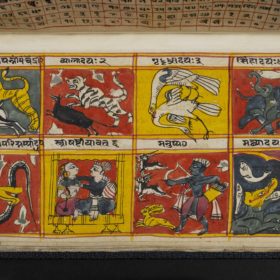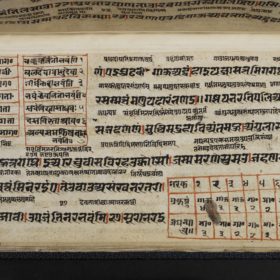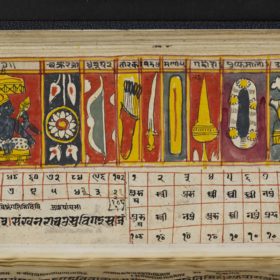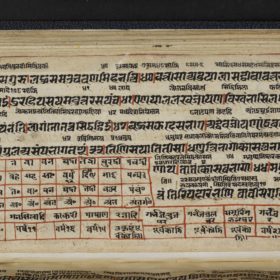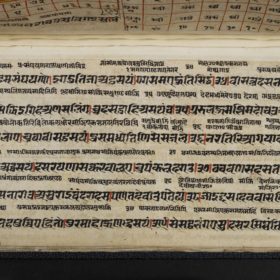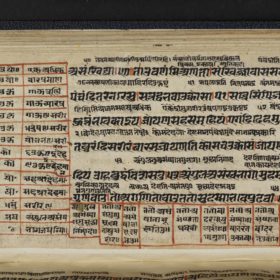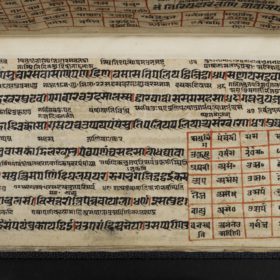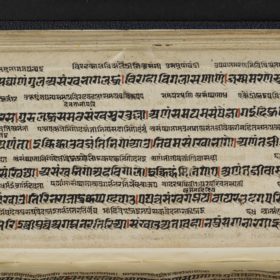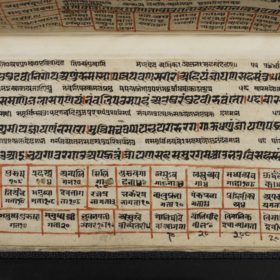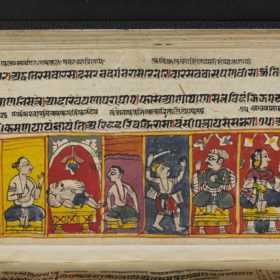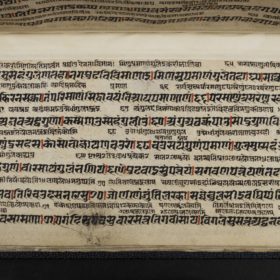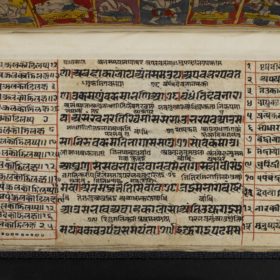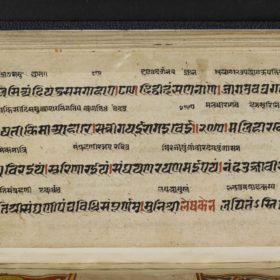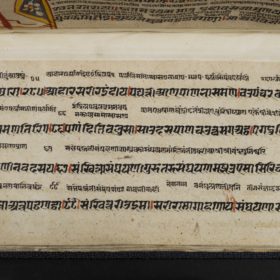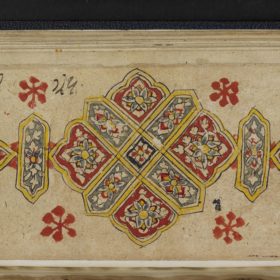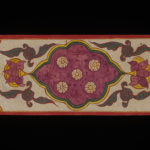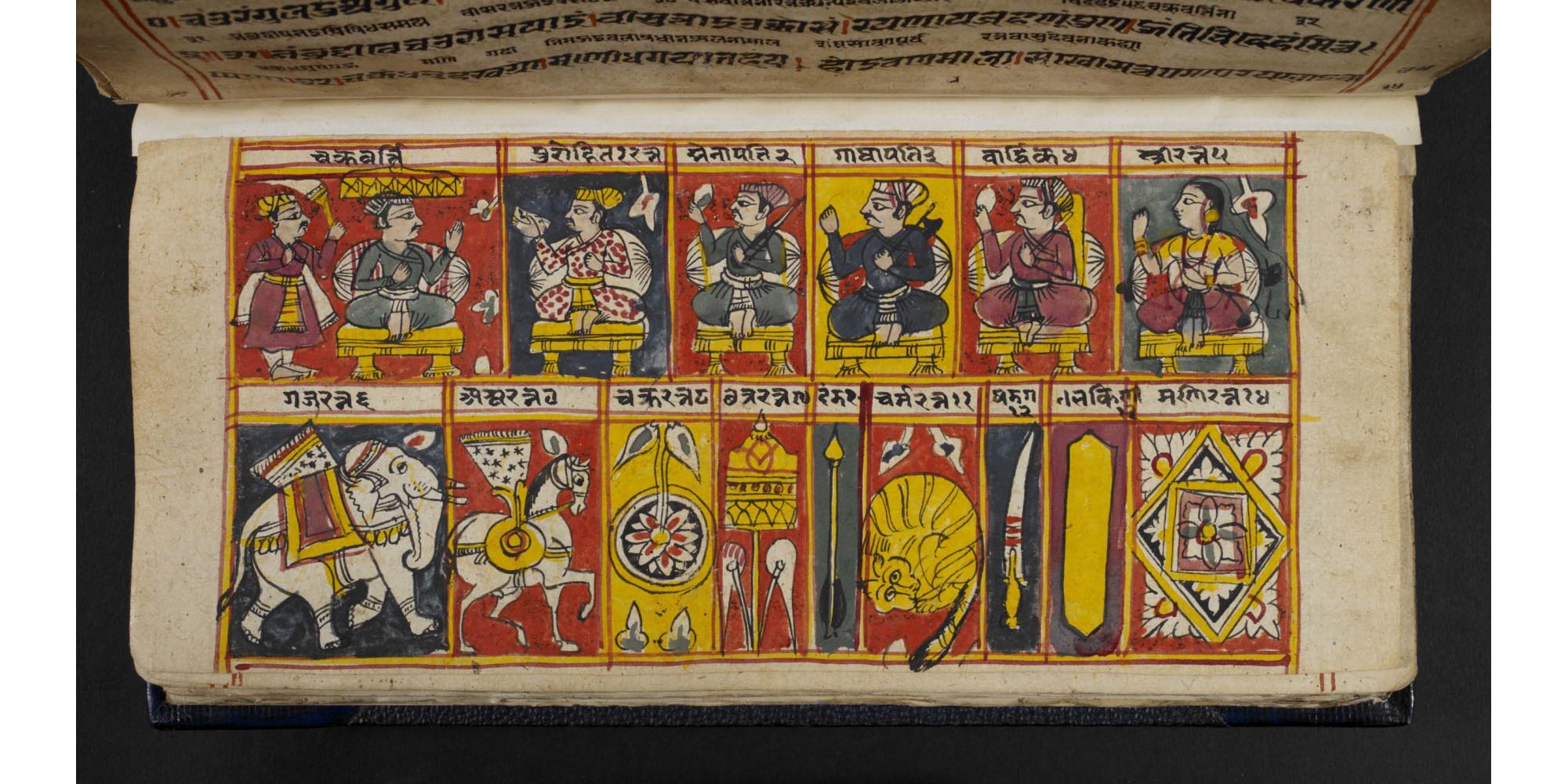
Background
There is a standard order for the 14 jewels. The first seven ones are either persons representing official functions that are useful for a king or animals valuable in conquest or battle. The others are magical objects.
A passage from Hemacandra's 12th-century epic in Sanskrit, the Triṣaṣṭiśalākāpuruṣa-caritra, shows how each of the jewels works and serves the conqueror.
Here Sagara, the second of the 12 universal monarchs, uses some of his jewels:
At an auspicious moment, after an auspicious ceremony had been performed by the family-priest, the King mounted the elephant-jewel, carrying the sword-jewel, for the expedition of universal conquest. Mounting the horse-jewel, carrying the staff-jewel, the general-jewel set out in front of the King. The priest-jewel, resembling the sun for removing the frost of all calamities, set out with the King. The steward-jewel, able to provide meals for the army at every camp […] set out with them. The carpenter, resembling Viśvakarman turned into a jewel, possessing power competent to make cities, etc., at once, went along. The umbrella- and skin-jewels, which expand from a touch of the hand, like clouds from the touch of a favourable wind, went along. The gem- and cowrie-jewels, able to destroy darkness, resembling the suns of Jambū-dvīpa diminished in size, accompanied him. The women of his household, like the shadow of the Cakrin’s body, went along, like a retinue of many slaves that had come from the Amazonian kingdom. The cakra [= discus, used as a weapon], like the King’s prestige, went ahead toward the east, its conquest of the heavens not repelled, lighting the sky from afar
Triṣaṣṭiśalākāpuruṣacaritra
Helen M. Johnson
vol. 2, page 139
Bold added.
Details of the jewels
The usefulness of some of these jewels is straightforward but explanations are needed for some.
Firstly, the umbrella-jewel spreads over 12 yojanas as soon as the king touches it. When he and his army come to the Vaitāḍhya mountain they are challenged by enemy kings, who cast spells to make heavy rains pour down. The unfurled umbrella can protect the whole army from the weather.
Next, the skin-jewel spreads itself below the umbrella as soon as the king touches it. It is said that grain sown on it in the morning will be ripe and ready for harvesting by the evening. Covering an area of 12 yojanas, it can therefore feed many people. In images of the 14 jewels, like the one here, the skin is normally shown in the shape of a kind of animal that is difficult to identify precisely.
Thirdly, the gem-jewel is made of beryl, a precious stone. It is either triangular or hexagonal in shape. However, the standard iconographic image is a many-faceted diamond shape enclosing a square, as is the case here. This gem provides bright light when the king enters the very dark cave of Tamisrā or other caves, through which he has to pass on his conquests. This gem also has protective powers to ward off disease, attacks and so on.
Lastly, the cowrie-jewel also supplies light. It is normally represented as it is here, in the form of a vertical slab. Made of gold, it is protective and can destroy poison. The rays of this cowrie-jewel shine over 12 yojanas. It can make night seem as day because it fully illuminates the caves where the conquering monarch and his army have to march.
Universal monarchs
A Cakravartin or universal monarch has 14 jewels – ratna – he can use as he wishes. He needs them to conquer the whole world instead of being just a local king with a limited empire. The universal monarchs are one of the categories of Great Men of Jain Universal History, like the Jinas, the Bala-devas, the Vāsu-devas, and the Prativāsu-devas. A future universal monarch is born in the world of humans after having been a god in the life before.
Saṃgrahaṇī-ratna
The Saṃgrahaṇī-ratna belongs to the tradition of Śvetāmbara writings on the Jain universe. The monk Śrīcandra wrote Prakrit verses in the 12th century consolidating previous writings on cosmology. It is called Jewel of Summarised Verses, a phrase which underlines the condensed nature of the work.
Though Saṃgrahaṇī works describe the universe, they are mainly concerned with the beings who live in different parts of the Jain world. They go into detail about their life-duration, karma and spiritual progress much more than the geography.
Cosmological writings have generated numerous commentaries in Sanskrit or the vernacular languages. This manuscript contains an anonymous Gujarati commentary in addition to the Prakrit verses.
Teaching and learning cosmology remain an important part of monastic education. A rich pictorial tradition has also grown up round the Saṃgrahaṇī works, as visualisation is part of the transmission of knowledge on the Jain universe and is helpful as a means of understanding. This manuscript is a carefully executed artefact with a large panel of paintings and charts. Unfortunately, it is not dated and has no information about those involved in producing it.
Jain cosmology is complex. Human beings live in the Middle World, which is the smallest of the three worlds that make up world space – loka-ākāśa. In world space all the souls live in the different body-forms they take according to their rebirths, in the various worlds. Outside world space is the non‑world space – aloka-ākāśa – which is endless. However, the Middle World is the most important area from the spiritual point of view because it is the only part where human beings can live.
Jains cannot advance spiritually without understanding and meditating upon cosmological theories so understanding them is crucial. Certain key religious concepts run through these theories. These include the notion of a physical soul shedding karma by moving through the cycle of rebirth to eventual omniscience and liberation, along with the cyclical nature of time, the interconnectedness of the universe, and the importance of symmetry, repetition and balance.
Glossary
Description
There are 15 panels in two rows, each panel with a caption. The captions and symbols in the panels reveal that this is a Cakravartin and his 14 jewels.
A Cakravartin or 'universal monarch' has 14 magical ‘jewels’ - ratna - he can use as he wishes, which he needs to become a universal monarch. There is a standard order for the 14 jewels, used here. The first seven are either persons representing official functions that are useful for a king or animals valuable in conquest or battle. The remaining ones are objects.
Top level
This shows the universal monarch on the left, facing the first five of his jewels, who are all human beings. In the first panel is the universal monarch himself and an attendant with a fly-whisk, with the caption cakravartti.
Moving right, the following panels show the jewel along with its name and number in the sequence:
- purohita - chaplain, priest-jewel
- senāpati – general-jewel who leads the army
- gāthāpati - treasurer-, steward- or manager-jewel, who manages the finances and who can provide enough food for an army
- vārddhika - carpenter or architect jewel, who can build a city in a day
- strī-ratna - woman-jewel or chief queen
Bottom level
This depicts the rest of the 14 jewels. The iconography of the inanimate objects is hard to work out without knowledge of the jewels. Moving from the left, the jewels are:
- gaja-ratna - elephant-jewel, which is a powerful animal in the army
- aśva-ratna - horse-jewel, which is invaluable in battle and immensely strong
- cakra-ratna - discus-jewel, which is an important weapon and form of transportation
- chatra-ratna - royal umbrella-jewel, which is an insignia of kingship and protects from the rain
- daṇḍa - staff-jewel or sceptre, which can protect a whole army from the weather
- carma-ratna - skin-jewel, which can provide enough wheat for an army in a day
- ṣaḍaga - sword-jewel
- nala or bhakiṇī - cowrie-jewel, which makes the night as light as day and protects against poison. The standard form of the word is kāgiṇī or kākiṇī
- maṇi-ratna - gem-jewel, which shines so brightly it illuminates darkness and protects against illness, attacks and so on.
- Source:
The British Library Board
- Shelfmark:
Or. 2116 ms. C
- Author:
Śrīcandra
- Date of creation:
perhaps 16th century
- Folio number:
36 recto
- Total number of folios:
44
- Place of creation:
western India
- Language:
Prākrit and Gujarati
- Medium:
paper
- Size:
25.7 x 11 cms
- Copyright:
CC0 1.0 (Creative Commons Public Domain)
- Image Copyright:
- +
- aAbhavya
- aAbhinandana
- aAbhiṣeka
- aĀcāra
- aĀcārāṅga-sūtra
- aĀcārya
- aAchalbhrata
- aAḍhāī-dvīpa
- aAdharma
- aAdho-loka
- aAdhyayana
- aAdvaita Vedānta
- aĀgama
- aAghātīya
- aAghātīya-karman
- aAgnibhuti
- aAgra
- aĀhāra
- aAhiṃsā
- aAhimsa Day
- aAjita
- aAjīva
- aAkampit
- aĀkāśa
- aAkbar the Great
- aAkṣaya-tṛtīyā
- aAlauddin Khalji
- aAlbert Einstein
- aAllah
- aAlms
- aĀlocanā
- aAloka-ākāśa
- aAmāri
- aAmbikā or Kūṣmāṇḍinī
- aAnagāra
- aAnanta
- aAnarthadaṇḍa
- aAnaśana
- aAnekānta-vāda
- aAṅga
- aAniconism
- aAnojjā
- aAntarāla
- aAntarāya-karma
- aAṇu
- aAṇu-vrata
- aAnukampā
- aAnuprekṣā
- aAnusvāra
- aApabhraṃśa
- aAparigraha
- aAra
- aĀrambha
- aĀrambhaja
- aĀratī
- aArdhamāgadhī Prākrit
- aArhaṃ
- aArhat
- aArśana-āvaraṇīya-karma
- aĀrta-dhyāna
- aĀryikā
- aĀryikā Jñānamati
- aĀśātanā
- aĀścarya
- aAscetic
- aAsceticism
- aAshram
- aAspiration
- aĀsrava
- aAṣṭa-maṅgala
- aAṣṭāpada
- aAstikāya
- aAstrolabe
- aAsura
- aAtheism
- aAticāra
- aAtiśayakṣetra
- aAtithisaṃvibhāgavrata
- aĀtma-vāda
- aĀtman
- aAuṃ
- aAurangzeb
- aAuspicious
- aAusterity
- aAvadhāna
- aAvadhi-jñāna
- aĀvaraṇī-yakarman
- aAvasarpiṇī
- aAvatāra
- aAvidyā
- aAxiom
- aĀyāga-paṭa
- aĀyambil
- aĀyu-karma
- aĀyurveda
- bBabur
- bBāhubali
- bBaladeva
- bBālāvabodha
- bBandha
- bBasadi
- bBazaar
- bBhadrankarvijay
- bBhagavant
- bBhaktāmara-stotra
- bBhakti
- bBhale
- bBharata
- bBhāṣā
- bBhāṣya
- bBhaṭṭāraka
- bBhāva
- bBhāva-pūjā
- bBhāvanā
- bBhavana-vāsin
- bBhavya
- bBhavyatva
- bBhaya
- bBhoga-bhūmi
- bBhogopabhoga
- bBodhi
- bBollywood
- bBrahmā
- bBrahma-deva
- bBrahmacārī
- bBrāhmaṇa
- bBraj Bhāṣā
- bBright fortnight
- bBritish Raj
- bBuddha
- bBuddhi-sagar
- bBuddhism
- bBuddhist
- cCaitya
- cCaityavāsin
- cCakravartin
- cCakreśvarī
- cCāmara
- cCandanā
- cCandragupta
- cCandraprabha
- cCanon
- cCāritra
- cCāritramohanīya-karman
- cCarũrī
- cCaste
- cCaturvidha-saṅgha
- cCaturviṃśati-stava
- cCāturyāma
- cCE
- cCelibacy
- cCha
- cChadmastha
- cChastity
- cCheda-sūtra
- cChristian
- cChristianity
- cClergy
- cCloning
- cColophon
- cCommentary
- cConch
- cConfession
- cCongregation
- cConsecration
- cCosmology
- cCremation
- cCrore
- cCult
- cCūrṇi
- dDādā-guru
- dDalit
- dDāna
- dDaṇḍa
- dDark fortnight
- dDarśana
- dDarśanamohanī-yakarman
- dDaśa-lakṣaṇa-parvan
- dDeity
- dDelhi Sultanate
- dDerāsar
- dDeśāvakāśika-vrata
- dDetachment
- dDevanāgarī
- dDevānandā
- dDevarddhi-gani
- dDevotee
- dDhamal
- dDhanuṣ
- dDhāra
- dDharma
- dDharma-dhyāna
- dDharma-sāgara
- dDharmastikaya
- dDhātakīkhaṇḍa
- dDholak
- dDhyāna
- dDiaspora
- dDig-vrata
- dDigambara
- dDīkṣā
- dDisciple
- dDīvālī
- dDivya-dhvani
- dDNA
- dDoctrine
- dDogma
- dDonor
- dDoṣa
- dDravya
- dDravya-pūjā
- dDrone
- dDuṣamā
- dDuṣamā-duṣamā
- dDuṣamā-suṣamā
- dDveṣa
- dDvīpa
- eEast India Company
- eEightfold Path
- eEkānta-vāda
- eEkendriya
- eElder
- eElders
- eEschatology
- eEtc up to
- fFarmān
- fFast
- fFatehpur Sikri
- fFestival
- fFestschrift
- fFiruz Shah
- fFly-Whisks
- fFolio
- fFour Noble Truths
- gGaccha
- gGaṇa
- gGaṇadhara
- gGanadharavada
- gGaṇeśa
- gGaṇin
- gGarba
- gGarbha
- gGarbha-gṛha
- gGaruḍa
- gGati
- gGene
- gGenomics
- gGhātī-yakarman
- gGhātīya
- gGhaznavid
- gGhiyasuddin Tughlaq
- gGhurid
- gGloss
- gGotra-karma
- gGujarāt
- gGujarati
- gGuṇa
- gGuṇa-sthāna
- gGuṇa-vrata
- gGupti
- gGuru
- gGuruṇī
- hHagiography
- hHajj
- hHaṃsa
- hHaribhadra
- hHariṇaigameṣin
- hHasta
- hHeresy
- hHiṃsā
- hHindi
- hHindu
- hHinduism
- hHīravijaya
- hHoroscope
- hHrīṃ
- hHumayun
- hHymn
- iIconoclasm
- iIconography
- iIdol
- iIndian Independence
- iIndology
- iIndra
- iIndrabhūti Gautama
- iIndriya
- iInitiation
- iIntercession
- iInvocation
- iIQ
- iIslam
- iIslamicate
- iIṣṭadevatā
- iĪśvara
- jJagat
- jJahangir
- jJain
- jJaina Devanāgarī
- jJaina Śaurasenī
- jJaina-dharma
- jJainaśāsana
- jJainness
- jJaisalmer
- jJamāli
- jJambū-dvīpa
- jJames Burgess
- jJanma
- jJanma-kalyāṇa
- jJarā
- jJāti
- jJina
- jJina-āgama
- jJina-bhavana
- jJina-bimba
- jJina-mātā
- jJinacandra-sūri
- jJinadatta
- jJinaprabha
- jJīva
- jJñāna
- jJñāna-āvaraṇīya-karma
- jJñāna-āvarṇiya
- jJñānsundar
- jJyotiṣka
- kKāla
- kKālakācārya-kathā
- kKālidāsa
- kKalpa-sūtra
- kKalpa-vṛkṣa
- kKalyāṇaka
- kKalyanvijay
- kKamaṇḍalu
- kKamaṭha
- kKarma
- kKarma-bhūmi
- kKarma-grantha
- kKarma-prakṛti
- kKarma-vāda
- kKarmon
- kKarnataka
- kKaṣāya
- kKathā
- kKāvya
- kKāya
- kKāyotsarga
- kKeśa-loca
- kKetu
- kKevala-jñāna
- kKevalin
- kKhalji
- kKharatara-gaccha
- kKnowledge
- kKriyā
- kKriyā-vāda
- kKṛṣṇa
- kKṣamā-śramaṇa
- kKṣapakaśreṇi
- kKṣatriya
- kKṣullaka
- kKulakara
- kKundakunda
- kKunthu
- lLabdhi
- lLaity
- lLakh
- lLāñchana
- lLands of Action
- lLaukāntika
- lLavaṇa-samudra
- lLeśyā
- lLiṅga
- lLinguistics
- lLoka
- lLoka-ākāśa
- lLoka-puruṣa
- lLoka-vāda
- lLotus
- lLotus lake
- mMadhya-loka
- mMahā-videha
- mMahā-vrata
- mMahābhārata
- mMahāmastakābhiṣeka
- mMāhārāṣṭra
- mMāhārāṣṭrī Prākrit
- mMahattarā Yākinī
- mMahāvīr Jayantī
- mMahāvīra
- mMakāra
- mMakkhali Gośāla
- mMalli
- mMāna-stambha
- mManaḥ-paryāya-jñāna
- mMaṇḍala
- mMaṇḍapa
- mMandit
- mMaṅgala
- mMantra
- mMantras
- mManuṣya-loka
- mMarāṭhī
- mMārgaṇā
- mMartyr
- mMarudevī
- mMaṭha
- mMati-jñāna
- mMauryaputra
- mMecca
- mMendicant lineage
- mMetarya
- mMiracle
- mMithyādṛṣṭi
- mMohandas Gandhi
- mMohanīya-karma
- mMokṣa
- mMonastic order
- mMonasticism
- mMonk
- mMonotheism
- mMosque
- mMount Meru
- mMount Sammeta
- mMṛgāvatī
- mMughal
- mMuhammad
- mMuhammad bin Tughlaq
- mMuhpattī
- mMūla-sūtra
- mMūlaguṇa
- mMumbaī
- mMuni
- mMunisuvrata
- mMurad Bakhsh
- mMūrti-pūjaka
- mMuslim
- mMysticism
- nNābhi
- nNāga-kal
- nNāgapurīya Tapā-gaccha
- nNāgarī
- nNāma-karma
- nNamaskāra-mantra
- nNami
- nNandīśvara-dvīpa
- nNandivardhana
- nNandyāvarta
- nNāraka
- nNāraki
- nNasalisation
- nNātha
- nNavrātrī
- nNaya-vāda
- nNemi
- nNidāna
- nniggaṃthāṇa vā 2
- nniggaṃtho vā 2
- nNigoda
- nNihnava
- nNikṣepa
- nNirgrantha
- nNirjarā
- nNirvāṇa
- nNiryukti
- nNiṣidhi
- nNitya
- nNiyati
- nNo-kaṣāya
- nNudity
- nNun
- oOcean of milk
- oOmniscience
- oOrdination
- ppa°
- pPadmaprabha
- pPadmāsana
- pPadmāvatī
- pPādukā
- pPalanquin
- pPalette
- pPañca-muṣṭi
- pPāṇḍava
- pPaṇḍit
- pPandit Dalsukh D. Malvania
- pPandit Sukhlalji
- pPāṇipātra
- pPāpa
- pParamātman
- pParameṣṭhin
- pPāraṇā
- pParigraha
- pPariṇāma
- pParīṣaha
- pParokṣa
- pPārśva
- pPārśvanātha
- pParyāya
- pParyuṣaṇ
- pPaṭa
- pPatan
- pPātra
- pPenance
- pPersian
- pPhala
- pPhilology
- pPicchikā
- pPilgrimage
- pPīr
- pPolymath
- pPoṣadha
- pPossession
- pPothī
- pPrabhas
- pPradakṣiṇā
- pPradeśa
- pPrākāra
- pPrakīrṇaka-sūtra
- pPrākrit
- pPramāda
- pPramukhā
- pPrati-vāsudeva
- pPratikramaṇa
- pPratimā
- pPratiṣṭhā
- pPratyākhyāna
- pPratyakṣa
- pPravacana
- pPrāyaścitta
- pPrayer
- pPre-modern
- pPreach
- pPredestination
- pProtestant
- pProvenance
- pPudgala
- pPūjā
- pPujārī
- pPukharavara-dvīpa
- pPuṇya
- pPūrva
- pPuṣkara-dvīpa
- pPuṣpadanta
- pPyre
- qQur’an
- rRāga
- rRāhu
- rRainy season
- rRajasthan
- rRajasthani
- rRājimatī
- rRajoharaṇa
- rRajput
- rRāma
- rRāmāyaṇa
- rRangoli
- rRās-garbā
- rRasa
- rRathanemi
- rRatna-traya
- rRātri-bhojana
- rRaudra-dhyāna
- rRecto
- rRelic
- rRenunciation
- rRetroflex
- rRevatī
- %Ṛg-veda
- rRite
- rRosary
- %Ṛṣabha
- %Ṛṣabhanātha
- rRupee
- sSaciyā Mātā
- sSādhu
- sSādhvī
- sSāgāra
- sSaint
- sŚaivaism
- sŚaka-saṃvat
- sSallekhanā
- sŚalya
- sSamacatuṣṭha
- sSamādhimaraṇa
- sSamaṇi
- sSāmarambha
- sSamavasaraṇa
- sSāmāyika
- sSaṃbhava
- sSamiti
- sSaṃjñā
- sSaṃkalpaja
- sSaṃsāra
- sSamudghāta
- sSaṃvara
- sSaṃvega
- sSamyak-cāritra
- sSamyak-darśana
- sSamyak-jñāna
- sSamyaktva
- sSaṃyama
- sSanctuary
- sSandalwood
- sSaṇgha
- sSanskrit
- sSant
- sŚānti
- sSapta-bhaṅgi-naya
- sSārambha
- sSarasvatī
- sSarvajña
- sSāsan-devi
- sŚāsana-devatā
- sŚāstra
- %Ṣaṭ-jīvanikāya
- sSatī
- sSatīmātā
- sSatya
- sSchism
- sScribe
- sScripture
- sSect
- sSecularism
- sŚenāī
- sSermon
- sŚeṣavatī
- sSevā
- sSeven fields of donation
- sShah Jahan
- sShantidas Jhaveri
- sShrine
- sSiddha
- sSiddha-śilā
- sSiddhacakra or Navadevatā
- sSiddhānta
- sSiddhārtha
- sSiddhi
- sSikh
- sSikhism
- sŚikṣā-vrata
- sŚīla
- sSin
- sSindh
- sŚītala
- sŚiva
- sSkandha
- sSomanatha
- sŚraddhā
- sŚramaṇa
- sŚrāvaka
- sŚrāvakācāra
- sŚrāvikā
- sŚreyāṃsa
- sŚrī
- sŚrīvatsa
- sŚruta-jñāna
- sŚruta-pañcamī
- sSthānaka-vāsin
- sSthāpanācārya
- sSthāvara
- sSthavira
- sSthiti
- sStrīmukti
- sStūpa
- sSubcontinent
- sSudarshana
- sŚuddhi
- sSudharma
- sŚūdra
- sSufism
- sSukha
- sŚukla-dhyāna
- sSulasā
- sSultan
- sSumati
- sSundarśrī
- sSupārśva
- sSūri
- sSuṣamā
- sSuṣamā-duṣamā
- sSuṣamā-suṣamā
- sSūtra
- sSuyam me ausam! Tenam bhagavaya evamakkhayam
- sSvādhyāya
- sSvāhā
- sSvastika
- sŚvetāmbara
- sŚvetāmbara Terāpanthin
- sŚvetāmbaras
- sSwan
- sSyād-vāda
- tTabla
- tTantra
- tTapā-gaccha
- tTapas
- tTāraṇ Svāmī Panth
- tTattva
- tTattvārtha-sūtra
- tTemple
- tTemple-city
- tThe Enlightenment
- tTheology
- tThree worlds
- %Ṭīkā
- tTilaka
- tTīrtha
- tTīrthaṃkaranāma-karman
- tTīrthankara
- tTransliteration
- tTrasa
- tTrasa-nāḍī
- tTriśalā
- tTriṣaṣṭi-śalākā-puruṣa-caritra
- tTti bemi
- tTughlaq
- tTunk
- uUdumbara
- uUniversal History
- uUpādhyāya
- uUpāṅga
- uUpaniṣads
- uUpāsaka
- uUpasarga
- uUpāśraya
- uŪrdhva-loka
- uUtsarpiṇī
- uUttarādhyayana-sūtra
- vVāhana
- vVaimānika
- vVairāgya
- vVaiṣṇava
- vVaiśramaṇa
- vVaiśya
- vValabhī
- vVanaspatikāya
- vVandana
- vVaṇik
- vVarṇa
- vVāsudeva
- vVāsupūjya
- vVayubhūti
- vVeda
- vVedanīya-karma
- vVegetarianism
- vVehicle
- vVernacular
- vVerso
- vVidyā
- vVidyā-devī
- vVihāra
- vVijñapti-patra
- vVikrama-saṃvat
- vVikṛti
- vVimala
- vVinaya
- vVipāka
- vVirji Vora
- vVirodhaja
- vVīrya
- vVisarga
- vViṣṇu
- vVītarāga
- vVizier
- vVotive
- vVow
- vVrata
- vVS
- vVyakta
- vVyantara
- vVyasana
- yYakṣa
- yYakṣī
- yYantra
- yYaśoda
- yYaśovijaya
- yYati
- yYātrā
- yYoga
- yYoginī
- yYojana
Description
There are 15 panels in two rows, each panel with a caption. The captions and symbols in the panels reveal that this is a Cakravartin and his 14 jewels.
A Cakravartin or ‘universal monarch‘ has 14 magical ‘jewels’ – ratna – he can use as he wishes, which he needs to become a universal monarch. There is a standard order for the 14 jewels, used here. The first seven are either persons representing official functions that are useful for a king or animals valuable in conquest or battle. The remaining ones are objects.
Top level
This shows the universal monarch on the left, facing the first five of his jewels, who are all human beings. In the first panel is the universal monarch himself and an attendant with a fly-whisk, with the caption cakravartti.
Moving right, the following panels show the jewel along with its name and number in the sequence:
- purohita – chaplain, priest-jewel
- senāpati – general-jewel who leads the army
- gāthāpati – treasurer-, steward- or manager-jewel, who manages the finances and who can provide enough food for an army
- vārddhika – carpenter or architect jewel, who can build a city in a day
- strī-ratna – woman-jewel or chief queen
Bottom level
This depicts the rest of the 14 jewels. The iconography of the inanimate objects is hard to work out without knowledge of the jewels. Moving from the left, the jewels are:
- gaja-ratna – elephant-jewel, which is a powerful animal in the army
- aśva-ratna – horse-jewel, which is invaluable in battle and immensely strong
- cakra-ratna – discus-jewel, which is an important weapon and form of transportation
- chatra-ratna – royal umbrella-jewel, which is an insignia of kingship and protects from the rain
- daṇḍa – staff-jewel or sceptre, which can protect a whole army from the weather
- carma-ratna – skin-jewel, which can provide enough wheat for an army in a day
- ṣaḍaga – sword-jewel
- nala or bhakiṇī – cowrie-jewel, which makes the night as light as day and protects against poison. The standard form of the word is kāgiṇī or kākiṇī
- maṇi-ratna – gem-jewel, which shines so brightly it illuminates darkness and protects against illness, attacks and so on.





























































































